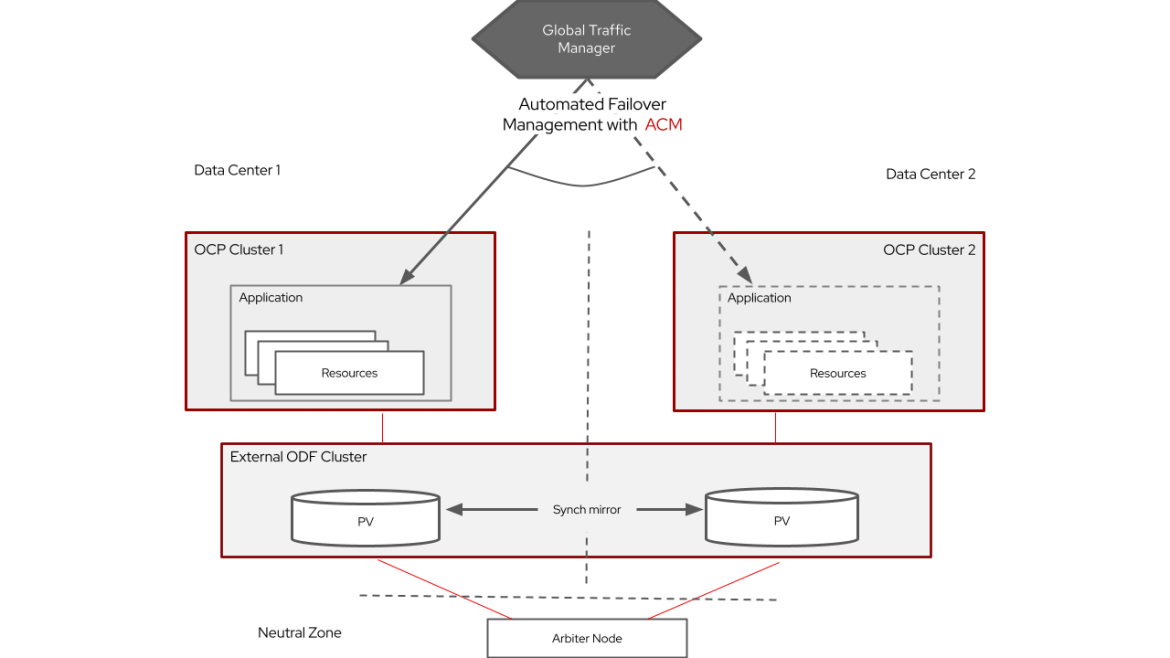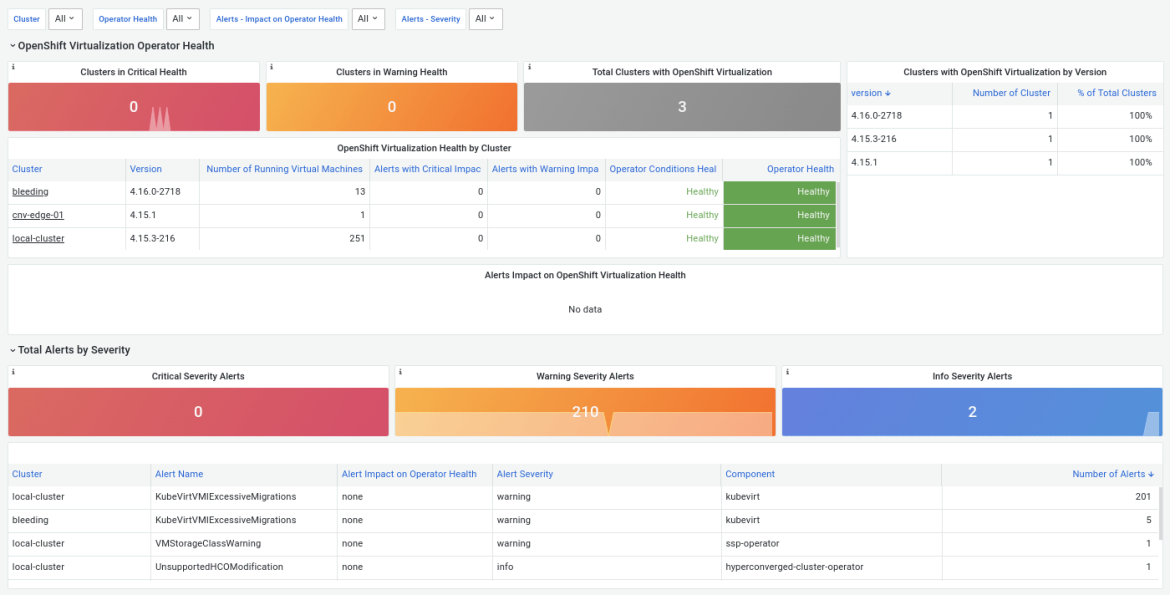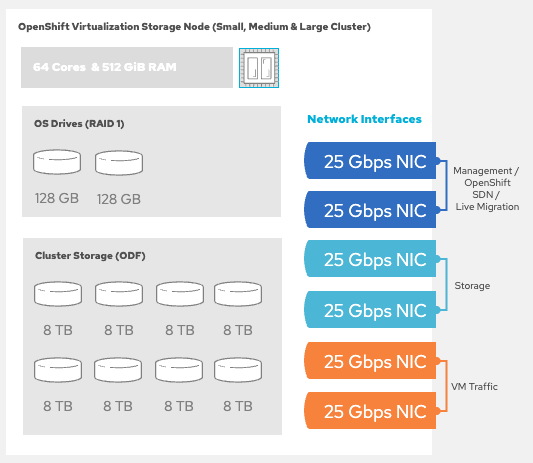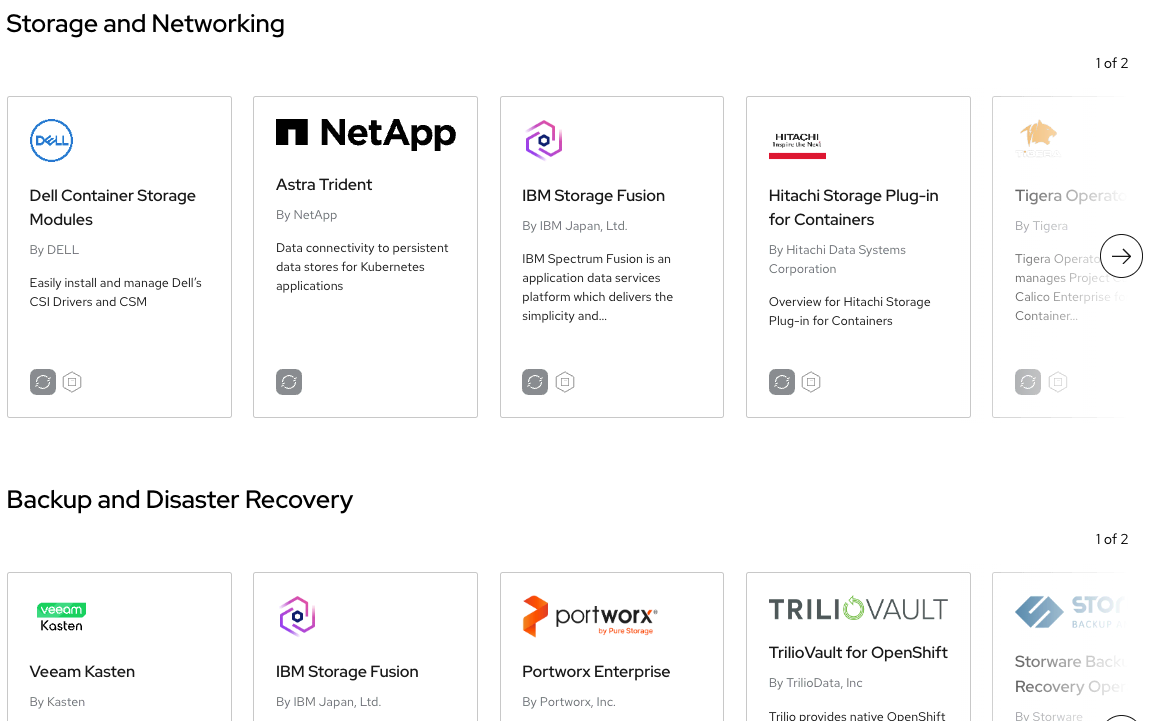Today we are announcing that Red Hat OpenShift Virtualization 4.16 is now generally available.
OpenShift Virtualization enables you to migrate your existing virtual machine (VM)-based workloads to Red Hat OpenShift, allowing you to modernize your operations. You can take advantage of the speed and simplicity of a comprehensive modern application platform, while preserving your existing virtualization investments. Here's some of what's new in our OpenShift Virtualization 4.16 release.
Scalable and flexible for demanding workloads
As users migrate more complex VM workloads to OpenShift, we’ve enabled a new set of capabilities to handle the most demanding requirements. These include:
- You can now vertically scale VM workloads with CPU hotplug, to dynamically handle bursts and seasonal increases for workloads that cannot afford any disruptions.
- You now have finer control over workload placement with the ability to specify node and affinity rules while the VM is running.
- Specialized workloads that require predictable performance and low latency can now run in real-time VMs.
- Microsoft Windows 10 VMs now boot using UEFI with TPM.
- You can now access VMs on a stable network endpoint using headless services.
Additionally, one of the most requested platform features is the ability to oversubscribe virtual resources like memory. This release includes a tech preview of safe memory overcommit, enabling swap for Kubernetes worker nodes. Try it out on your non-production workloads—we think you’ll like it and we’re interested in your feedback.
Protect your business critical workloads with Red Hat OpenShift Data Foundation
Seasoned admins know you need to have a plan in case of emergency, in the event of power failure, network outage, or a weather related catastrophe. Every organization should have in place a disaster recovery (DR) plan to help keep their business running with minimum disruptions or data loss. You can achieve zero data loss (RPO) and minimal recovery times (RTO) with OpenShift Data Foundation and Red Hat Advanced Cluster Management for Kubernetes for metro disaster recovery, now generally available for all VM workload types.

If your business continuance requirements are not as strict, there is also regional disaster recovery using OpenShift Data Foundation and Red Hat Advanced Cluster Management, available in technology preview for VMs deployed and managed using GitOps. We encourage you to try with non-production workloads and send us your feedback.
Manage your workloads at greater scale
Our new dashboard in Red Hat Advanced Cluster Management Observability provides comprehensive insights for each cluster with the OpenShift Virtualization operator installed. The dashboard displays the state of the operator, determined by active OpenShift Virtualization alerts and the operator's health. Additionally, it shows the number of running VMs and the operator version for each cluster. The dashboard also lists alerts affecting the operator's health and separately includes all OpenShift Virtualization alerts, even those not impacting the operator's health. Users can filter the dashboard by cluster name, operator health alerts, health impact of alerts and alert severity.

This scales in even larger environments with the global hub providing a global search feature over your ACM-Hub cluster. Lastly, you can export CSV data from search for further processing outside of Red Hat Advanced Cluster Management.
Migrate faster with MTV 2.6
To make your infrastructure modernization journey as easy as possible, you can migrate production workloads from VMware vSphere, Red Hat Virtualization and Red Hat OpenStack Platform with this included and easy-to-use VM migration toolkit utility. Highlights of the Migration Toolkit for Virtualization 2.6 (MTV) include:
- Direct migration from standalone ESXi - You can now migrate VM workloads without VMware vCenter.
- Migration over a secure connection - You are now able to specify a CA signed certificate to be used for authenticating the server that runs vCenter or ESXi, depending on the specified SDK endpoint of the vSphere provider.
Check out this demo on how to use the Migration Toolkit for Virtualization.
Embed this video <https://www.youtube.com/watch?v=5zossjikJm8>
Guidance from experts
As we’ve met with customers that have a variety of infrastructure architectures, we have developed opinions, suggestions and recommended practices for OpenShift configuration when deploying VMs. Our experts have created the OpenShift Virtualization Reference Implementation Guide. Think of it as a set of opinionated guidance for small, medium and large deployments.

Using the combined knowledge and experience of our virtualization history and platform innovations, you have a great starting point for designing and architecting your own scalable infrastructures.
For an inside look at how our Red Hat Performance and Scale team gets the most out of their hardware, check out our new learning path, How to create and scale 6,000 virtual machines in 7 hours with Red Hat OpenShift Virtualization.
Great collaboration with ecosystem partners
We continue to have great success with our current ecosystem partners who’ve added support for OpenShift Virtualization. Read more about our partners who have rigorously tested VMs on OpenShift.

Further, we have a deep engineering collaboration with data protection partners like Kasten by Veeam, Trilio, Storware and Portworx. And, if you want reassurance for other storage providers, you can validate your VM storage deployment with the same KubeVirt storage checkup our storage partners use to validate their CSI operators.
Learn about OpenShift Virtualization at an event near you
Red Hat is hosting numerous events globally that feature Red Hat OpenShift Virtualization. Sign up for an event in your city using the links below. You’ll also see that we partner with AWS to feature OpenShift Virtualization on our managed offering, Red Hat OpenShift Service on AWS .
- Red Hat Summit Connects
- Red Hat User Groups (RHUG) meetups
- Red Hat OpenShift Virtualization Roadshow
- AWS Summit Connects
Wrap up
OpenShift Virtualization 4.16 continues to deliver on scalability both from a workload and management perspective, providing operational flexibility, and helping protect your business critical workloads. With enhancements in the Migration Toolkit for Virtualization combined with the guidance available from experts, it is easier to bring your VM workloads to OpenShift Virtualization. We continue to build out a comprehensive ecosystem of partners and hope to see you at an event in a city near you.
Become a certified specialist
As with other Red Hat platforms, like Red Hat Enterprise Linux (RHEL) and OpenShift, modernizing your infrastructure and operations is a skill set that is valuable for both your company and career. You can continue your training to become a Red Hat Certified Specialist in OpenShift Virtualization.
Learn more
- OpenShift Virtualization: Why Bring Your Virtual Machines to Kubernetes?
- OpenShift Virtualization blogs
- OpenShift Virtualization demos on demo.openshift.com
- OpenShift Livestream
- OpenShift TV library of recorded OpenShift videos and streams
Upstream project and community
Red Hat initiated and continues to be a leading contributor to KubeVirt, the upstream CNCF project that users and vendors are adopting to integrate virtual machines in Kubernetes. We are also seeing additional companies choosing KubeVirt as a proven key technology.
Explore the upstream innovation from the KubeVirt 2024 Summit.
Über die Autoren
Peter is a product manager in Cloud Platforms, focused on virtualization. He has been in high tech for storage, virtualization, databases, and hyperconverged solutions for longer than he cares to admit.
Courtney started at Red Hat in 2021 on the OpenShift team. With degrees in Marketing and Economics and certificates through AWS and Microsoft she is passionate about cloud computing and product marketing.
Mehr davon
Nach Thema durchsuchen
Automatisierung
Das Neueste zum Thema IT-Automatisierung für Technologien, Teams und Umgebungen
Künstliche Intelligenz
Erfahren Sie das Neueste von den Plattformen, die es Kunden ermöglichen, KI-Workloads beliebig auszuführen
Open Hybrid Cloud
Erfahren Sie, wie wir eine flexiblere Zukunft mit Hybrid Clouds schaffen.
Sicherheit
Erfahren Sie, wie wir Risiken in verschiedenen Umgebungen und Technologien reduzieren
Edge Computing
Erfahren Sie das Neueste von den Plattformen, die die Operations am Edge vereinfachen
Infrastruktur
Erfahren Sie das Neueste von der weltweit führenden Linux-Plattform für Unternehmen
Anwendungen
Entdecken Sie unsere Lösungen für komplexe Herausforderungen bei Anwendungen
Original Shows
Interessantes von den Experten, die die Technologien in Unternehmen mitgestalten
Produkte
- Red Hat Enterprise Linux
- Red Hat OpenShift
- Red Hat Ansible Automation Platform
- Cloud-Services
- Alle Produkte anzeigen
Tools
- Training & Zertifizierung
- Eigenes Konto
- Kundensupport
- Für Entwickler
- Partner finden
- Red Hat Ecosystem Catalog
- Mehrwert von Red Hat berechnen
- Dokumentation
Testen, kaufen und verkaufen
Kommunizieren
Über Red Hat
Als weltweit größter Anbieter von Open-Source-Software-Lösungen für Unternehmen stellen wir Linux-, Cloud-, Container- und Kubernetes-Technologien bereit. Wir bieten robuste Lösungen, die es Unternehmen erleichtern, plattform- und umgebungsübergreifend zu arbeiten – vom Rechenzentrum bis zum Netzwerkrand.
Wählen Sie eine Sprache
Red Hat legal and privacy links
- Über Red Hat
- Jobs bei Red Hat
- Veranstaltungen
- Standorte
- Red Hat kontaktieren
- Red Hat Blog
- Diversität, Gleichberechtigung und Inklusion
- Cool Stuff Store
- Red Hat Summit


